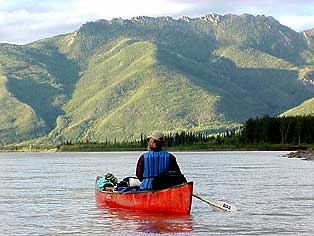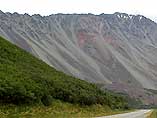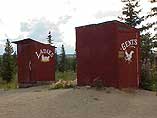 |  | |
YUKON RIVER
CANOEING
The Yukon River originates in Canada and flows all the way through the Yukon Territory and Alaska to the Bering Sea. Approximately 2,000 miles in length, this broad, flat and fast river is the third longest river in North America. Our trip begins near the United States-Canada border at the small town of Eagle, Alaska. From here, we will paddle approximately 185 miles to the next small town of Circle, Alaska. Most of the trip will be in the 2.5 million acre Yukon-Charley Rivers National Preserve which was originally established in 1978 to protect peregrine falcons. One-fifth of the peregrine falcons in the world occurs along the bluffs of the Yukon River in Alaska and its tributaries.
During our float trip down the Yukon River, we will pass the Seventymile, Tatonduk, Nation, Kandik and Charley Rivers in addition to smaller creeks and ghost towns that played an important role in the gold rush of the late 1800s. Largely untouched by glaciers during the last Ice Age, the bluffs, mountains and surrounding lands of the Preserve contain evidence that aboriginal people lived in this part of Alaska over 11,000 years ago. The complete depositional record of over 760 million years and persistence of fossils is unique in America, indicating that warm shallow seas, cold ocean bottoms and turbulent continental shelves once covered this area. There is also evidence of volcanic activity and continental collisions.
Wildlife observation is always a highlight of any trip in Alaska. During our float trip, we could see moose, fox and bears along the banks of rivers. Linx, beaver, river otter, porcupines and wolverine are present, but less likely to be seen. The higher elevations are calving grounds for the Fortymile caribou herd; one of Alaska’s largest. Along with the caribou are wolf packs that sometimes can be heard howling. Dall sheep can be seen at the highest elevations. In addition to peregrine falcons, eagles, osprey, hawks (sharp-shinned, rough-legged and red-tailed), northern harriers, goshawks, kestrels and gyrfalcons can be seen. Ptarmigan, geese, swans and ducks are common. Fishing along the clear side streams and sloughs is great for catching Arctic grayling, sheefish, pike and burbot.
LOGISTICS
This 10-day trip begins with a flight from Fairbanks, Alaska, to Eagle, Alaska. In addition to canoeing the Yukon River, we will take hikes to look for birds and wildlife, fine remnants of the gold rush era and explore the many rivers feeding the Yukon River. There will be plenty of time for taking photographs, fishing if you are inclined, relaxing and soaking up the sky, mountains and vast wilderness of Yukon River country. If the aurora borealis is active, you are in for a special treat.
Experiencing and enjoying the wilderness are the primary goals of our trip; however, we would be missing out if we did not attempt to understand what it must have been like to live in the early days of settlement in the region. Campsites on beaches and along river bars with colorful bluffs and mountains as backdrops are the perfect settings for a tradition. Each evening, we take turns reading from the poetry of Robert Service and the works of Jack London.
If the weather cooperates, we should arrive in Circle, Alaska, on our second to last day. From here, we’ll load up the canoes and our camping gear and drive to Arctic Circle Hot Springs near Center, Alaska. After checking into our accommodations for the evening, we'll have plenty of time to soak off the crude of nine days on the river as we enjoy the famous hot springs.
Our final day will be spent driving the Steese Highway, 162 miles back to Fairbanks. Our path will take us over Birch Creek, a National Wild and Scenic River, into the Steese National Conservation Area and through a variety of forest types and open tundra. We'll take time out to hike wherever it seems appropriate. As we get closer to Fairbanks and civilization, we will see evidence of gold mining left by current and past gold prospectors and the Alaska oil pipeline.
Although high temperatures can reach into the 90s and low temperatures can drop below freezing during the summer in Interior Alaska, most likely the temperatures will range from a high in the 70s to a low in the 40s.
What We Provide. We provide canoe and canoeing gear, camp kitchen and camping supplies, meals beginning with lunch the first day and ending with dinner on the tenth day, bush plane flight from Fairbanks to Eagle, ground transportation from Circle to Center and then back to Fairbanks and at least one guide/naturalist.
Your Responsibility. Guests are responsible for getting to the small plane airport in Fairbanks on the first day of the trip. Guests are also responsible for light weight rain gear, comfortable foot wear that can get wet, water bottle, appropriate clothing for the season, hat, tent, ground cloth, sleeping bag and pad, sunscreen, insect repellent and/or headnet and lodging in Fairbanks before and after the trip. Finally, guests are responsible for any extra bag weight fees on our flights into the backcountry. Tents, ground cloths, sleeping bags and pads can be provided for an additional fee.
Trip Fee & Reservations. The trip fee is $2,684 per person. A $1,060 per person deposit is due at the time the reservation is made. The balance is due six weeks prior to the trip. Reservations made 30 days before the trip begins must be paid in full before the trip begins. Please call for rental prices for tents, ground clothes, sleeping bags and pads.
Cancellation Policy. Any cancellation made prior to 30 days before the trip begins will result in a $650 per person cancellation fee. Any cancellation made during the 30 days before the trip begins will result in a $1,060 per person cancellation fee. If the trip is canceled by Alaska Personal Journeys, the trip fee will be refunded. It is recommended that cancellation insurance be purchased through a travel agency in case the trip is canceled in order to cover non-refundable expenses such as airline and hotel fees.
Dollar-A-Day for Conservation. All of the courses and trips offered by Alaska Personal Journeys are intended to raise public awareness to the need to protect our environment. We hope you will consider contributing one dollar per day to support the work of local conservation groups doing their best to protect Alaska's special places. Simply add one dollar per day to the Alaska Personal Journeys trip fee. We will make sure that your contribution gets to the most effective conservation groups and that the group or groups sends you a receipt for tax deduction purposes.
ITINERARY
The following itinerary may be modified due to weather and water conditions or wildlife viewing opportunities. The itinerary is intended to give guests a general idea of what to expect.
Day 0. Group participants meet to discuss trip logistics. Dutch treat dinner.
Day 1. Meet at the Fairbanks small plane airport early in the morning. Catch a bush plane flight to Eagle, Alaska. Brief tour of Eagle. Load canoes. Begin paddling the Yukon River to Circle, Alaska. Set-up camp.
Day 2-4. Break camp. Paddle. Explore sites of interests along the way. Hike when the opportunity presents itself. Set-up camp.
Day 5. Layover day in the wilderness.
Day 6-8. Break camp. Paddle. Explore sites of interests along the way. Hike when the opportunity presents itself. Set-up camp.
Day 9. Break camp. Paddle to Circle. Unload canoes and load van. Drive to Central, Alaska. Check into Arctic Circle Hot Springs to spend the evening. Soak in the hot springs.
Day 10. Check out of Arctic Circle Hot Springs. Drive back to Fairbanks along the Steese Highway stopping along the way. Arrive in Fairbanks in time for a farewell dinner. Drop guests off at either the airport or place of lodging in Fairbanks.
 |  |  |
Copyright © 2003-10 by Alaska Personal Journeys • P.O. Box 76 • Clam Gulch, AK 99568-0076
